In the vast and chaotic expanse of the Warhammer 40,000 universe, one name embodies desire, hedonism, and the relentless pursuit of perfection: Slaanesh, the Chaos God of Excess, Pleasure, and Pain.
While Khorne revels in bloodshed and Nurgle in decay, Slaanesh entices mortals and immortals alike through beauty, passion, and the promise of ultimate satisfaction.
Yet, beneath this façade of pleasure lies a ravenous, insatiable hunger—one that devours even the souls of those who seek to fulfill their deepest yearnings.
Origins of Slaanesh: The Tragic Fall of the Aeldari
In the ancient times before humanity had risen to prominence among the stars, the Aeldari were the rulers of a vast and sophisticated empire that spanned countless worlds.
They were a race of unparalleled beauty, grace, and intellect, possessing technology and psychic abilities that enabled them to shape reality itself.
However, within this power lay the seeds of their destruction, for the Aeldari began to view themselves not merely as masters of the universe but as beings above moral consequence.
Over time, their culture, once rooted in artistry, beauty, and harmony, spiraled into decadence and corruption.
The Golden Age of the Aeldari
In its height, the Aeldari empire was a beacon of civilization. Sculptors, poets, and philosophers thrived, each vying to capture new dimensions of thought and beauty. Entire worlds were dedicated to a single art form, be it music, sculpture, or dance.
Aeldari poets could sing tales so powerful they could induce visions or transport the listener into a state of transcendent ecstasy. Sculptors created forms so perfect that mortals who gazed upon them often wept, overwhelmed by their splendor.
The Aeldari’s psychic gifts allowed them to tap into higher realities, heightening every aspect of their perception.
Their artistry extended beyond the physical realm. Aeldari warlocks and seers worked alongside architects and engineers to design cities where psychically resonant crystals hummed harmoniously with the emotions of their inhabitants.
In these dreamlike metropolises, Aeldari could experience art and life in a way that was impossible for any other race. They could feel the colors in a painting, hear the emotions in a statue, and taste the sound of a melody.
Yet, as time passed, this pursuit of beauty transformed into an insatiable hunger for ever-greater pleasure and sensation.
The Descent into Hedonism
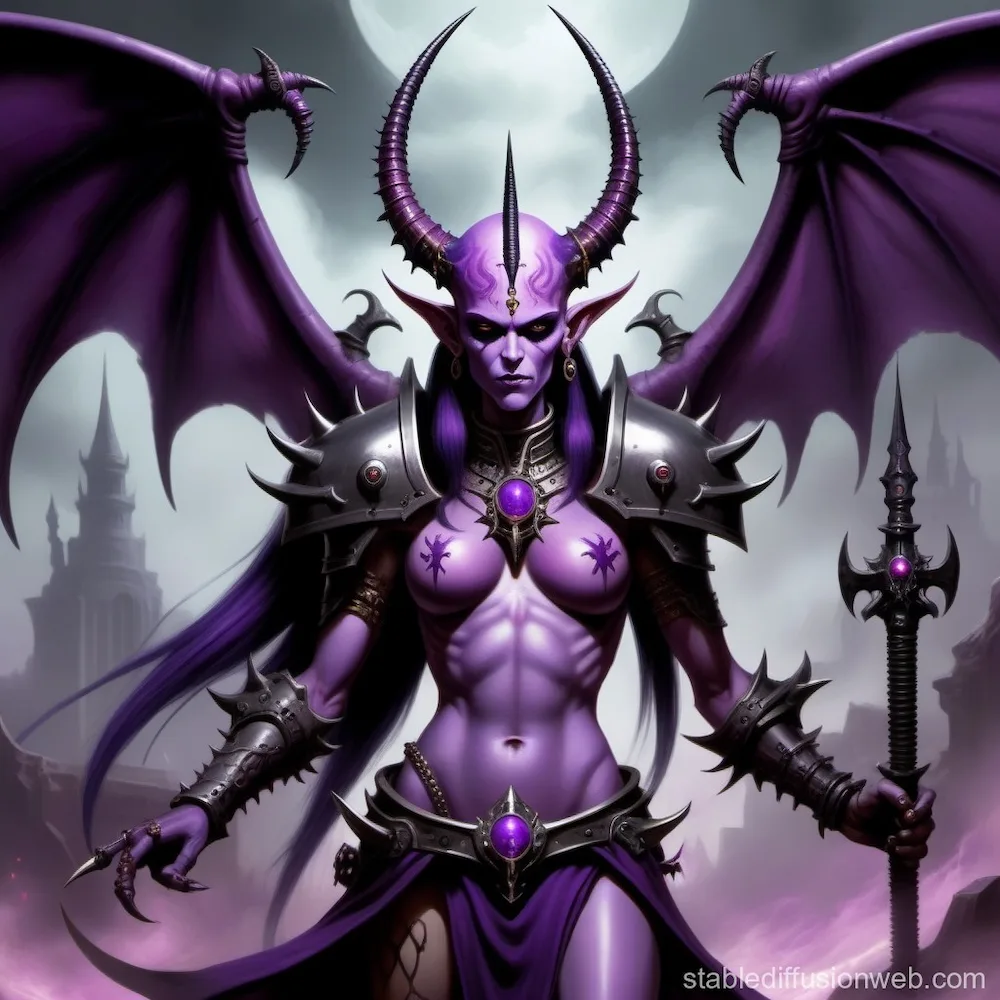
The decline of the Aeldari began subtly, like the first delicate crack in a flawless crystal. Aeldari society, once harmonious and unified, began to fracture into pleasure-seeking subcultures.
Initially, these cults were dedicated to art, beauty, and the pursuit of knowledge. But as their society grew more insular, these pursuits became twisted and perverse.
No longer satisfied with creating beauty, many Aeldari sought to dominate it, pushing the boundaries of their emotions and sensations to dark extremes.
Pleasure cults dedicated to excess and indulgence sprang up across their empire, each dedicated to exploring a specific aspect of sensation, whether it was pain, ecstasy, or even fear.
The Aeldari began to indulge in activities that would have once horrified them, using psychic powers to warp their own perceptions, push the boundaries of pain and pleasure, and delve into perverse rites that distorted their very souls.
Entire worlds were dedicated to these cults, where beings gave themselves over to their desires in grand and hedonistic spectacles.
For millennia, this cultural descent continued unchecked. Aeldari worlds that had once been centers of learning and art transformed into decadent pleasure palaces, where inhabitants reveled in their desires, seeking new ways to satisfy their insatiable hunger for sensation.
Even as their empire began to show signs of internal decay, the Aeldari could not pull themselves back from the precipice.
The Birth of Slaanesh
As Aeldari society spiraled further into excess, the psychic energies of their desires, fears, and perversions began to coalesce within the Warp.
The raw, unchecked emotions of billions of Aeldari fed this embryonic Chaos God, nurturing it into being. This dark presence in the Warp grew in strength and malevolence, fed by every act of decadence and depravity.
Finally, in a cataclysmic moment that would be remembered as the Fall, the entity now known as Slaanesh was born. The Aeldari’s psychic echoes across the galaxy screamed out in terror and ecstasy as Slaanesh awoke, and in a single, terrible instant, the God of Excess devoured the souls of billions.
The explosion of psychic energy tore a permanent wound in reality, creating the Eye of Terror, a region where the Warp and realspace overlap, trapping the souls of the Aeldari and resonating with their eternal torment.
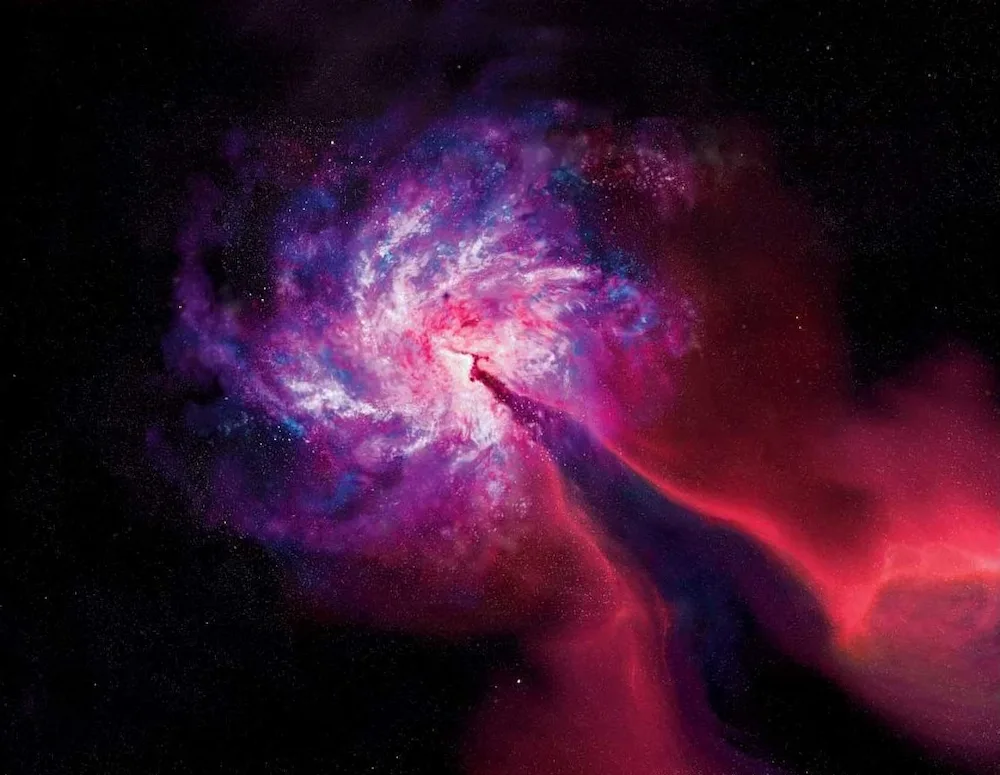
In that instant, the Aeldari race was shattered. Countless Aeldari died as Slaanesh claimed their souls, devouring them to fuel its own power.
The god’s very existence was a reflection of their darkest desires and most twisted dreams, a being of unparalleled beauty and terror that held sway over every passion and vice.
To this day, Slaanesh hungers for the souls of the Aeldari, whose psychic energies continue to sustain the god’s existence.
The Aftermath: A Broken Race
The few Aeldari who survived the Fall were irrevocably changed. Many fled to the newly formed Craftworlds—massive, self-sustaining starships that had been created as a precaution by those who foresaw the empire’s collapse.
These Craftworld Aeldari dedicated themselves to a path of discipline and restraint, seeking to control their emotions and desires, lest they draw the attention of Slaanesh.
They adopted the use of spirit stones, devices that capture the soul of an Aeldari upon death, to protect them from the eternal hunger of the Dark Prince.
Other survivors took darker paths. Some became the Drukhari, or Dark Eldar, fleeing into the Webway to escape Slaanesh’s reach.
They embraced cruelty and sadism, indulging in acts of torture and suffering that, while twisted, allowed them to sustain their existence without falling prey to Slaanesh.
Through the infliction of pain on others, the Drukhari found a way to replenish their own life force, keeping the Prince of Excess at bay—at least temporarily.
The final group of Aeldari are the enigmatic Harlequins, who travel freely through the Webway, preserving the stories of their people and honoring the trickster god Cegorach.
These warriors-actors dance along the edge of Chaos, defying Slaanesh by celebrating life, death, and the endless dance of the Aeldari’s tragic history.
The Many Faces of Slaanesh: A God of Endless Titles
Slaanesh is a god of countless faces and identities, each reflecting a facet of the Chaos God’s dominion over mortal experience and sensation. Some of the most recognized titles include:
- The Dark Prince: Emphasizing Slaanesh’s mastery over desire and forbidden pleasures.
- She-Who-Thirsts: In Warhammer 40,000, this name reflects the devastating birth of Slaanesh, which consumed countless Aeldari souls.
- The Prince of Pleasure and The Lord of Excess: These titles highlight Slaanesh’s role in amplifying emotions, creativity, and personal indulgence.
- The Master of Perfection: As the patron of obsession, Slaanesh promises those who seek beauty and excellence an endless road of improvement.
- The Fulfiller of Dreams and Passions: Slaanesh is the god of dreamers, artists, and those who strive for the sublime, often luring them with the idea that they can reach heights of ecstasy and fulfillment.
Exploring the Realm of Slaanesh: The Six Circles of Temptation
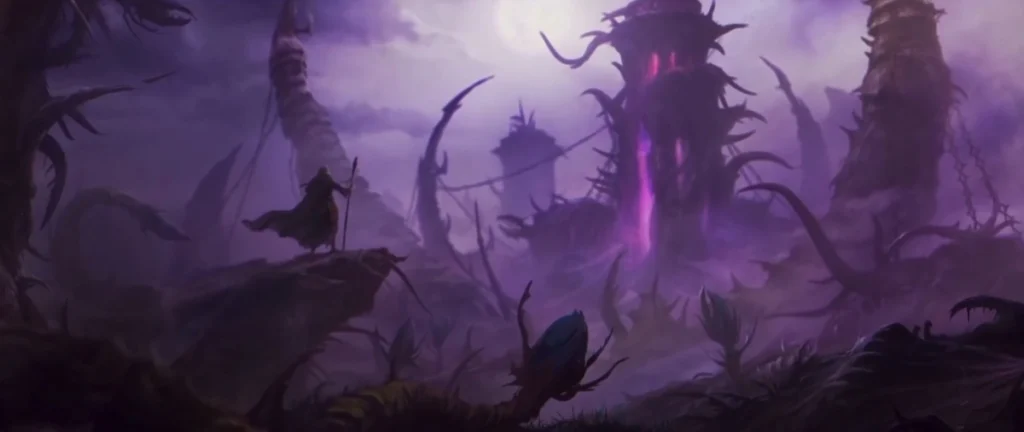
Slaanesh’s realm within the Warp is a surreal, ever-shifting landscape where beauty and horror intertwine, seducing the minds and senses of those who wander into its domain.
Mortals who find themselves here are led through six circles of temptation, each representing an aspect of excess and desire that Slaanesh embodies.
Within these circles, Slaanesh’s followers—daemonettes, fiends, and more—tempt, torment, and consume those who succumb.
The First Circle: The Garden of Yearning
The journey begins in the Garden of Yearning, a place where mortals are confronted by the unfulfilled desires that once haunted them. It appears as a lush, verdant paradise, filled with flowers of impossible beauty and fruit that exudes intoxicating scents.
Each plant whispers secrets of hidden pleasure and untapped ambition, coaxing wanderers to reach out and fulfill their deepest longings.
However, those who do so find themselves ensnared, their minds overwhelmed by insatiable desire that slowly consumes their will. Here, they are offered what they once lacked, only to find it is never quite enough.
In this circle, Slaanesh’s daemonettes weave through the foliage, playing with their prey, offering glimpses of further pleasure just beyond reach.
Some are lured deeper, unable to resist the temptations that Slaanesh has so artfully crafted, while others are left yearning, their minds forever haunted by unfulfilled dreams.
The Second Circle: The Valley of Sensation
Those who pass through the Garden of Yearning are led to the Valley of Sensation, where every sensory experience is heightened to the extreme. The very air vibrates with energy, and colors seem to shimmer with an unnatural, almost hypnotic glow.
The slightest sound becomes a symphony, and the faintest touch an electric thrill. In this place, mortals are overwhelmed by their senses; even the simplest sensations, like the feel of grass beneath their feet or the sound of a distant melody, become maddeningly intense.
Here, visitors are offered pleasures that push the boundaries of physical sensation. Slaanesh’s minions perform delicate yet depraved acts to test the limits of each wanderer’s tolerance for pleasure and pain, blending the two until they are indistinguishable.
Those who give in become addicted to the intensity, seeking ever greater experiences that ultimately lead them deeper into Slaanesh’s thrall.
The Third Circle: The Hall of Mirrors
The Hall of Mirrors is a place of introspection and self-obsession. Visitors find themselves surrounded by reflections, each mirror showing a different aspect of themselves—sometimes more beautiful, sometimes more terrible. They are forced to confront their deepest vanities, insecurities, and flaws.
Here, Slaanesh offers them the chance to improve, change, or transform themselves, a tantalizing prospect for those who are unsatisfied with who they are.
The mirrors promise a glimpse of perfection, of beauty and power beyond imagining. Many mortals lose themselves here, captivated by their own reflections and the visions of what they could become. Those who attempt to alter their reflections often find themselves twisted by Slaanesh’s influence, transformed into something monstrous, yet alluring.
In the Hall of Mirrors, mortals can lose their sense of identity, becoming so absorbed in the reflection that they forget who they truly are.
The Fourth Circle: The Courtyard of Indulgence
The Courtyard of Indulgence is a place of boundless luxury and excess. Here, tables laden with the most exquisite food and drink stretch for miles, attended by daemonettes who ply mortals with fine wines and rare delicacies.
Every indulgence, every excess, is at their fingertips, with no limits and no consequences. Mortals who wander here are encouraged to feast, to sate their appetites, to live without restraint or consequence.
This is a trap as much as a gift, for in Slaanesh’s realm, every indulgence leads only to further hunger. The more mortals partake, the more they are consumed by their appetites.
Eventually, they find themselves unable to stop, their desires spiraling out of control. Many are left as hollow shells, endlessly consuming but never satisfied, forever trapped in a cycle of insatiable indulgence.
The Fifth Circle: The Palace of Pleasure
Beyond the Courtyard lies the Palace of Pleasure, Slaanesh’s own seat of power. Here, mortals are invited into chambers adorned with lavish decorations and opulent finery.
Every room offers a new experience, a new sensation, each more intense and addictive than the last. The walls themselves seem to pulse with life, as if responding to the passions and desires of those within.
In the Palace of Pleasure, Slaanesh presents itself to mortals, not as a monstrous entity, but as a figure of unimaginable beauty and allure. The Dark Prince whispers promises of ultimate satisfaction, of desires fulfilled beyond mortal comprehension.
Many who reach this place fall utterly under Slaanesh’s sway, willingly offering their souls to the god of excess in exchange for an eternity of pleasure. They become lost within the palace, their minds and bodies given over to Slaanesh’s eternal embrace.
The Sixth Circle: The Abyss of Despair
For those who resist even the Palace of Pleasure, there lies one final trial: the Abyss of Despair. This place is a stark, desolate void, devoid of sensation, color, or sound.
It is the opposite of everything Slaanesh represents, a place where mortals are stripped of all pleasure, all joy, all feeling. Here, they are left alone with nothing but the silence and emptiness of their own minds.
The Abyss is Slaanesh’s final test, a place where even the most disciplined souls are broken. It is a reminder of what life is like without desire, without sensation, without passion.
Many who reach this place beg for Slaanesh’s mercy, pleading for even a taste of the pleasures they once resisted. In the end, they are drawn back into the fold, forever bound to the Prince of Excess.
Slaanesh’s Rivalries with Other Chaos Gods
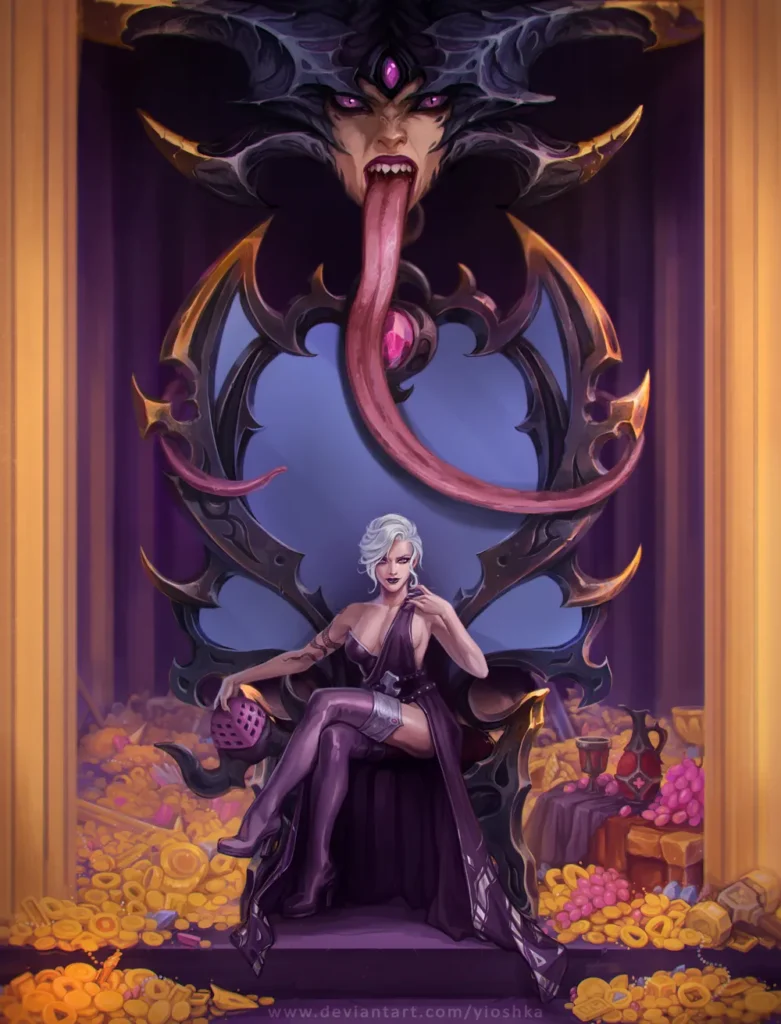
To fully understand the complex and enduring rivalries between Slaanesh and the other Chaos Gods, we must look beyond the superficial differences of their domains and into the deeper ideological clashes that define their relationships.
Each Chaos God embodies a particular aspect of the dark desires and chaotic impulses that can consume mortal souls. Slaanesh, as the god of excess, pleasure, and hedonism, seeks a kind of ultimate sensory domination—a control over the mortal experience that is seductive, invasive, and total.
This ambition places Slaanesh in natural opposition to the other Chaos Gods, whose powers derive from fundamentally different (often contradictory) forms of chaos and corruption.
Let’s explore these rivalries in detail:
1. Slaanesh vs. Khorne: The Passion of Pleasure Against the Fury of Rage
The rivalry between Slaanesh and Khorne, the Blood God, is perhaps the most infamous of the conflicts among the Chaos Gods. Khorne’s domain is that of martial honor, unrestrained anger, and the raw, destructive power of battle.
For Khorne, violence is an end in itself, pure and brutal, embodying the harshest aspects of survival and dominance. Slaanesh, by contrast, is equally passionate but channels that passion into sensation and pleasure.
- Clashing Ideals: Khorne views Slaanesh’s indulgences as weakness. To him, beauty, luxury, and hedonism are unnecessary distractions that soften warriors and weaken resolve. Where Khorne finds glory in the purity of a clean kill and the discipline of martial prowess, Slaanesh celebrates the delicate nuances, the intricate dance of a fight, and the perfection of form and technique. Slaanesh’s followers do not kill purely for the sake of it; they kill to experience the beauty of the act itself, the thrill of domination, or the artistry of the blade. This subtlety and decadence make Khorne recoil in disgust, seeing it as the height of dishonor and indulgence.
- Aesthetic and Symbolic Contrasts: The symbolism between these two gods reinforces their opposition. Khorne’s worshippers are brutish, often bloodstained and clad in red and brass, displaying the primal rage of their god. Slaanesh’s followers, however, are beautiful, their armor adorned with intricate designs, pastels, and decadent fineries. This garishness offends Khorne’s sensibilities, and the Blood God’s disdain only fuels Slaanesh’s desire to prove that his path—filled with art, beauty, and pleasure—can be just as powerful, if not more so, than the path of bloodshed.
- The Chalice of War: A famous story exemplifies this rivalry. Slaanesh, in an attempt to sway Khorne, crafted a beautiful chalice and gifted it to the Blood God. The chalice, an object of profound artistry, was a physical embodiment of Slaanesh’s philosophy: to blend function and beauty in a way that would elevate even the act of killing. But Khorne, repulsed by this “soft” beauty, smashed the chalice in fury. Yet he found himself compelled to gather its pieces and reassemble it, only to break it again in frustration. This endless cycle symbolizes the trap of attraction and revulsion Khorne feels toward Slaanesh—a hatred so consuming that it borders on obsession.
2. Slaanesh vs. Nurgle: Beauty Against Decay, Vitality Against Resignation
If Slaanesh is the embodiment of perfection and sensory overload, Nurgle represents the acceptance of imperfection, decay, and the inevitability of entropy. Nurgle’s power is rooted in the concepts of disease, rot, and the comforting embrace of despair.
For Nurgle, life is about the acceptance of suffering as a universal constant, and his followers find peace in submission to life’s harshness and the grotesque beauty of decay.
- Philosophical Conflict: Slaanesh abhors Nurgle’s acceptance of entropy. To Slaanesh, stagnation and decay represent the ultimate failure—an end to experience, pleasure, and the relentless pursuit of self-perfection. For Slaanesh, each moment should be filled with sensation, and there is no room for resignation. In contrast, Nurgle sees Slaanesh’s constant striving as a futile denial of life’s natural order. Nurgle offers comfort in the face of despair, urging his followers to embrace the imperfections of their existence, while Slaanesh promises endless, feverish sensation as a means of transcending mortal limits. This difference in worldview makes them diametrically opposed forces within the Warp.
- The Temptation of Nurgle’s Followers: Nurgle’s followers find contentment in their suffering and disease, which makes them resilient to Slaanesh’s allure. The idea of constant desire, longing, and ambition is a foreign concept to them, and thus they resist Slaanesh’s seductions with surprising ease. For Slaanesh, this resistance only intensifies the allure of corrupting Nurgle’s followers, and the Dark Prince constantly seeks ways to draw these “unreachable” souls into his thrall, often to little effect.
- The Rivalry on the Battlefield: On the battlefield, followers of Slaanesh are elegant, graceful, and precise, whereas Nurgle’s minions are bloated, grotesque, and relentless. This contrast extends to their fighting styles: Slaanesh’s warriors dance through battle, reveling in the thrill of every strike, while Nurgle’s forces advance slowly, absorbing blows with stoic indifference. To a Slaaneshi warrior, the battle is an art; to a Nurgle follower, it is simply part of the inevitable cycle of life and death.
3. Slaanesh vs. Tzeentch: The Pursuit of Pleasure vs. the Desire for Change
The rivalry between Slaanesh and Tzeentch, the Changer of Ways, is perhaps the most subtle but also the most insidious.
Tzeentch embodies the constant quest for knowledge, mutation, and the manipulation of fate. His followers seek enlightenment, often at any cost, embracing change and the unpredictable nature of the universe.
Slaanesh, by contrast, seeks the perfection of sensation, the endless pursuit of pleasure, and the mastery of experience.
- Opposing Desires: Slaanesh’s followers are driven by a need for fulfillment and satisfaction, which can take many forms but is ultimately rooted in the pursuit of pleasure and excess. Tzeentch’s followers, however, are never satisfied, seeking endless change, secrets, and evolution. To Slaanesh, the constant shifting of Tzeentch’s realm and the chaos of his schemes are distasteful—Slaanesh seeks stability in sensation, an eternal state of pleasure and ecstasy. Tzeentch, on the other hand, sees Slaanesh’s fixation on pleasure as static and unambitious, lacking the transformative power that only true change can bring.
- The Perfection vs. Transformation Paradox: Where Tzeentch believes in the infinite potential for change and mutation, Slaanesh believes in the infinite potential for refinement. Slaanesh’s followers strive to perfect themselves, pursuing a vision of beauty or sensation that they believe to be absolute. Tzeentch’s followers, however, are ever-changing, embracing the concept that nothing can remain constant and that transformation itself is the ultimate form of power. Slaanesh’s notion of beauty and the “perfect moment” is, in Tzeentch’s eyes, a foolish ideal. To Slaanesh, Tzeentch’s shifting reality is an endless spiral with no destination, devoid of true satisfaction.
- Competing Temptations: Tzeentch’s followers, consumed by the pursuit of knowledge, often find themselves drawn to Slaanesh’s promises of ultimate pleasure as a “final reward” for their labors. Tzeentch, aware of Slaanesh’s ability to seduce his followers, places barriers to prevent this allure, guarding his followers’ minds against Slaanesh’s temptation of eternal satisfaction. Slaanesh, meanwhile, seeks to corrupt Tzeentch’s most devoted disciples, hoping to demonstrate that even knowledge itself is hollow compared to the true pleasure he offers.
The Endless Rivalries of the Warp
These rivalries reveal a fundamental truth about the Chaos Gods: while they are united in their corruption of the mortal realm, they are locked in eternal opposition to each other, each vying to embody the “ultimate” form of Chaos.
Slaanesh’s relationships with Khorne, Nurgle, and Tzeentch highlight the many faces of the Ruinous Powers, each God reflecting a dark aspect of human nature that resonates with certain mortals while repelling others.
This perpetual competition, known as the Great Game, ensures that while the Chaos Gods seek dominion over all reality, they are simultaneously forever at odds, their ambitions locked in an unbreakable and complex web of rivalry, opposition, and fleeting alliances.
In the end, it is this conflict that keeps the Warp in a state of perpetual chaos, mirroring the endless struggles within the hearts of mortals.
The Followers of Slaanesh: A Study of Devotion and Decadence
The allure of Slaanesh attracts a myriad of followers, from the desperate and broken to those simply seeking something more profound than what mortal life can offer.
Slaanesh’s followers are as varied as the temptations the Dark Prince offers, spanning from corrupted individuals and cultists to entire noble houses and empires whose ambitions and decadence push them into Slaanesh’s grasp.
These followers give the Chaos God a powerful presence in the mortal realms and make Slaanesh’s influence one of the most insidious among the Dark Gods, as it can manifest subtly, appearing as beauty, perfection, or joy.
Warriors and Champions of Slaanesh
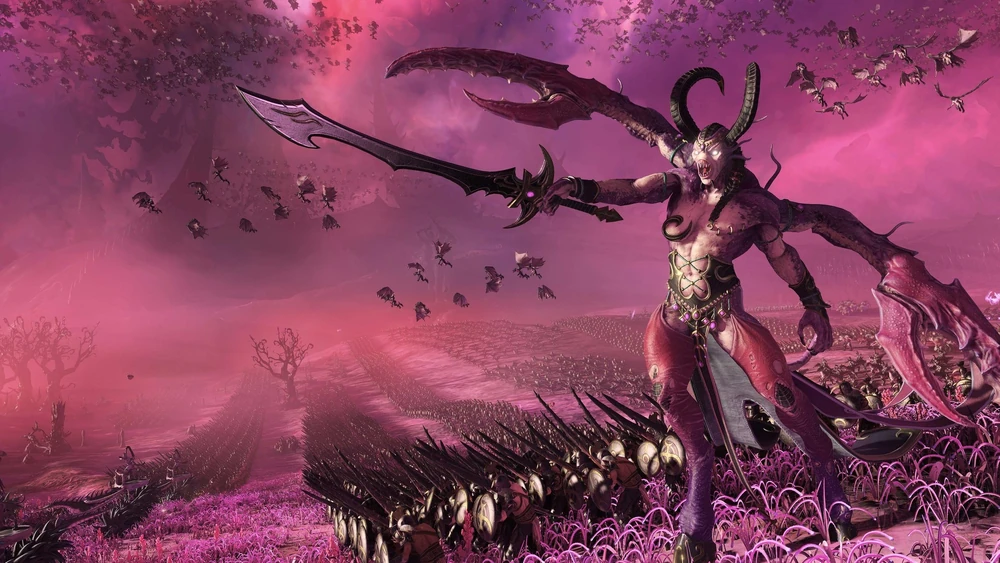
Not all who worship Slaanesh do so through art and pleasure; some come to the Dark Prince through the thrill of battle and the desire for perfection in combat.
Warriors drawn to Slaanesh are often those who seek to perfect their martial skills or crave the sensation of victory. They view combat as the ultimate expression of personal prowess, and in Slaanesh, they find a god who values and rewards their ambition.
These warriors are transformed into Champions of Slaanesh, blessed with supernatural agility, grace, and reflexes. They become killing machines, their movements flowing with an elegance that defies human limitation.
On the battlefield, they revel in the ecstasy of combat, their senses heightened to perceive every strike, parry, and death in excruciating detail. To them, battle is not merely violence; it is art, a performance that allows them to indulge their desire for mastery.
Across the galaxy, certain individuals embody Slaanesh’s ideals more completely than others, serving as paragons of excess and dark glory. These champions are more than cultists or fanatics; they are vessels through which Slaanesh’s will is realized, often granted powers that defy understanding and mutations that reflect their inner corruption.
Fulgrim, the Phoenician
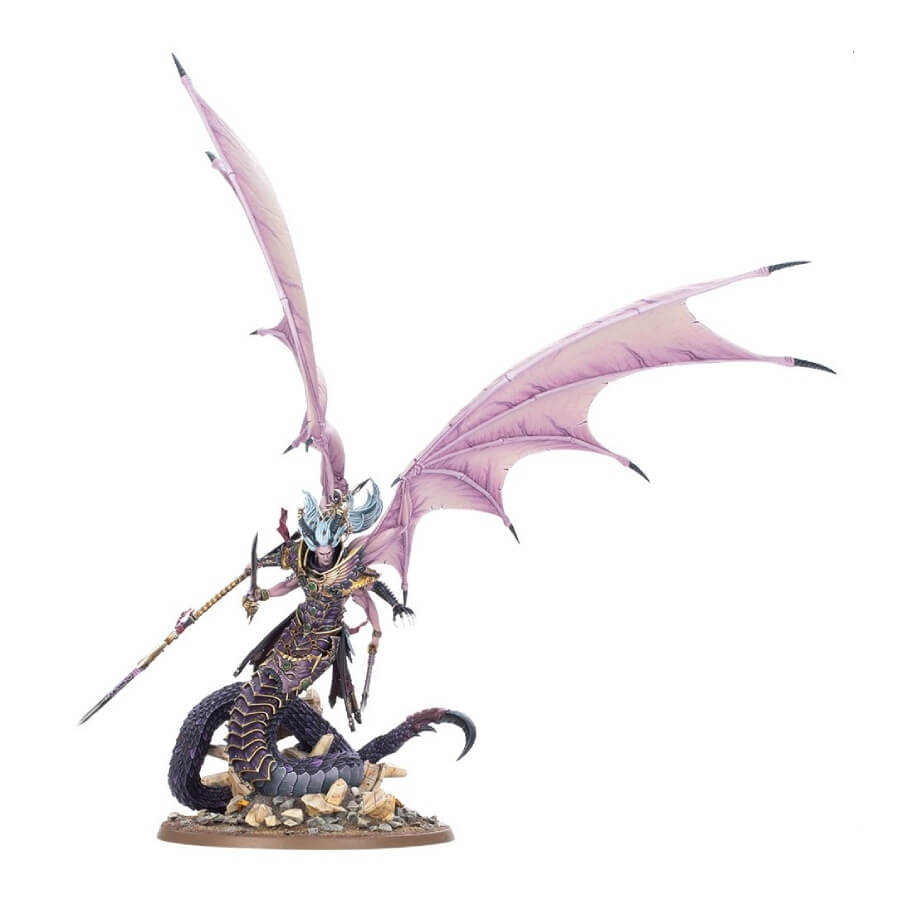
Fulgrim, the Primarch of the Emperor’s Children, is perhaps Slaanesh’s most tragic and renowned devotee. Originally a loyal servant of the Emperor, Fulgrim’s pursuit of perfection led him down a dark path. Under Slaanesh’s influence, he succumbed to temptations of beauty, ambition, and personal glory.
The Primarch ultimately became one of Slaanesh’s chosen, embodying the aesthetic and destructive potential of his patron god.
Fulgrim’s transformation into a daemon prince solidified his place as one of Slaanesh’s foremost champions, a paragon of the pleasures and perils of the Dark Prince’s embrace.
Lucius the Eternal: The Exemplar of Vanity
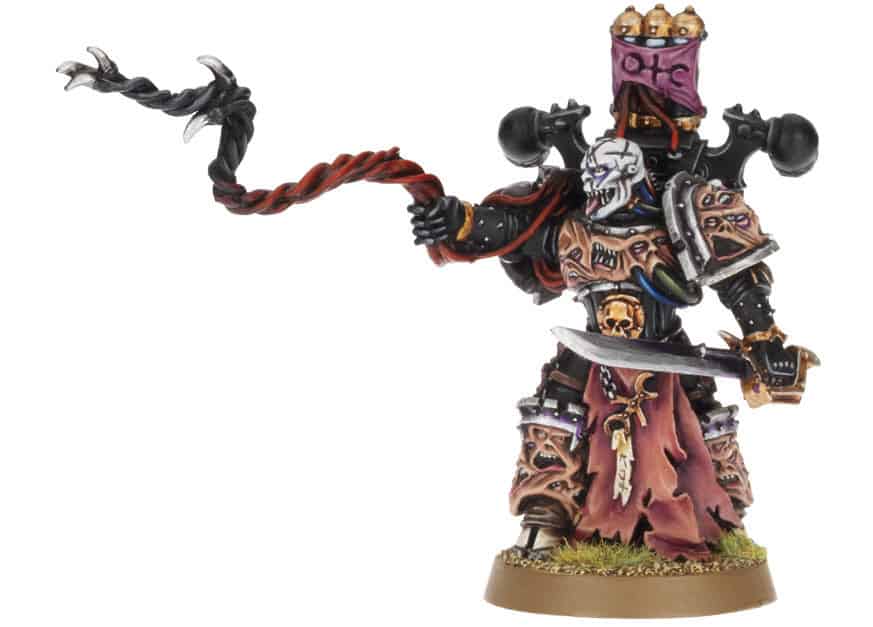
Among the most infamous of Slaanesh’s champions is Lucius the Eternal, a Chaos Space Marine whose pride and arrogance have granted him a terrifying form of immortality.
Once a captain of the Emperor’s Children, Lucius was a peerless duelist who sought perfection in every engagement.
His vanity became his undoing, as he fell to Slaanesh not through failure but through his belief that no one could truly best him.
Cursed by his own arrogance, Lucius cannot truly die. Any individual who kills him, regardless of their intentions, will find themselves slowly transforming into Lucius, their body twisted into his form as his consciousness consumes theirs.
In this way, Lucius “lives on” through his killers, spreading his vanity and pride across the stars, a testament to Slaanesh’s twisted sense of perfection.
Fabius Bile: The Fleshcrafter’s Pursuit of Perfection
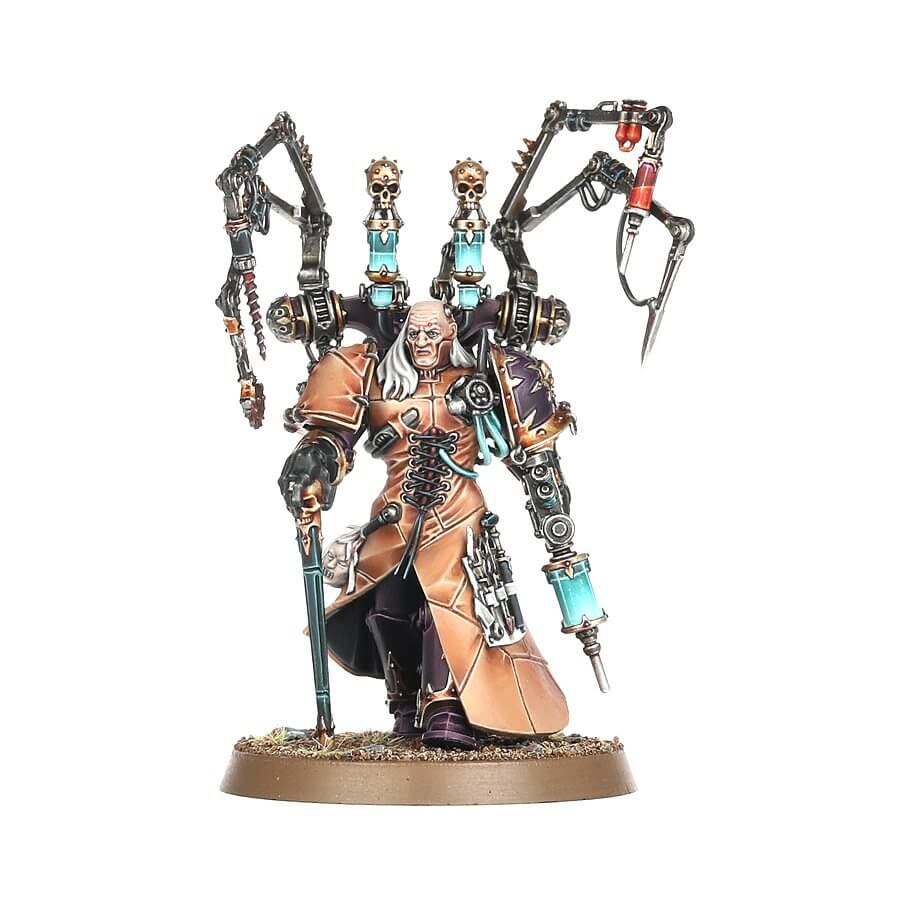
Fabius Bile, another former Emperor’s Child, serves Slaanesh not out of devotion but through his insatiable desire to master genetics and biology. Known as the “Clone Lord,” Bile sees himself as a scientist rather than a servant of Chaos, yet his methods and ambitions align him with Slaanesh.
His experiments are grotesque, involving the creation of malformed life forms, the enhancement of Chaos Space Marines, and attempts to clone the Primarchs. Bile’s fascination with transcending the limitations of flesh and creating his own ideal of perfection make him a twisted icon of Slaanesh’s philosophy.
Bile’s relationship with Slaanesh is complex. He seeks mastery over life itself, yet he is also a slave to his own pursuits. His disregard for morality and the suffering of his creations exemplifies the extremes to which the Dark Prince can drive its followers.
Bile’s work, while monstrous, is the product of a mind that has been completely overtaken by a thirst for ultimate knowledge and mastery.
N’Kari, Keeper of Secrets
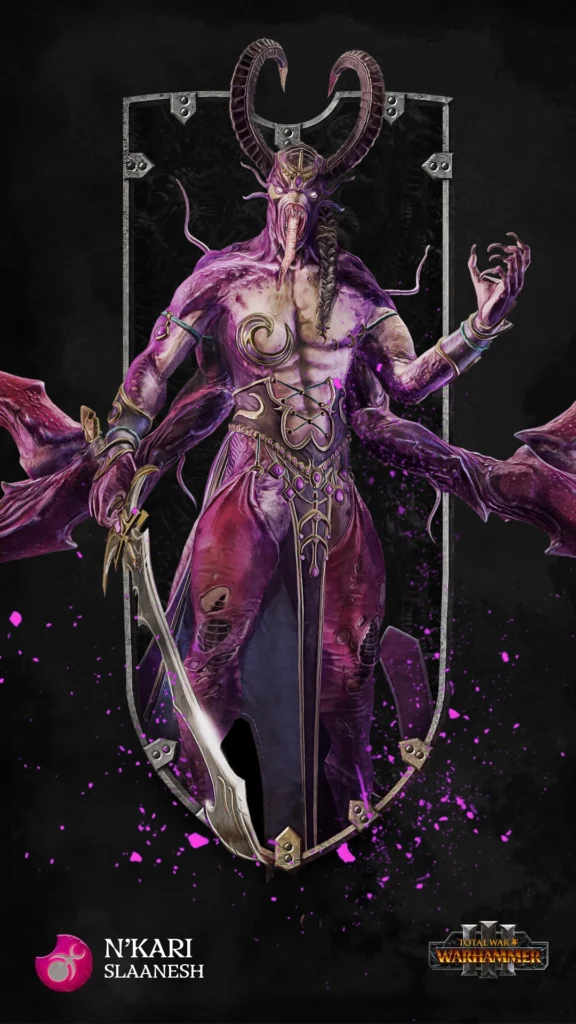
N’Kari is one of Slaanesh’s Greater Daemons, known as the Keeper of Secrets. N’Kari has existed since the earliest days of Slaanesh’s rise and is a master of manipulation, weaving webs of desire and discord to ensnare mortals and daemons alike.
With an unsettlingly alluring form—part beast, part beauty—N’Kari embodies the duality of Slaanesh’s gifts: overwhelming attraction coupled with horror.
Over millennia, N’Kari has clashed with many of the galaxy’s greatest heroes, including the legendary Aeldari Farseer Eldrad Ulthran and the forces of the Imperium.
Each encounter fuels N’Kari’s thirst for vengeance and pleasure, making this daemon one of the Dark Prince’s most formidable agents.
Sigvald the Magnificent
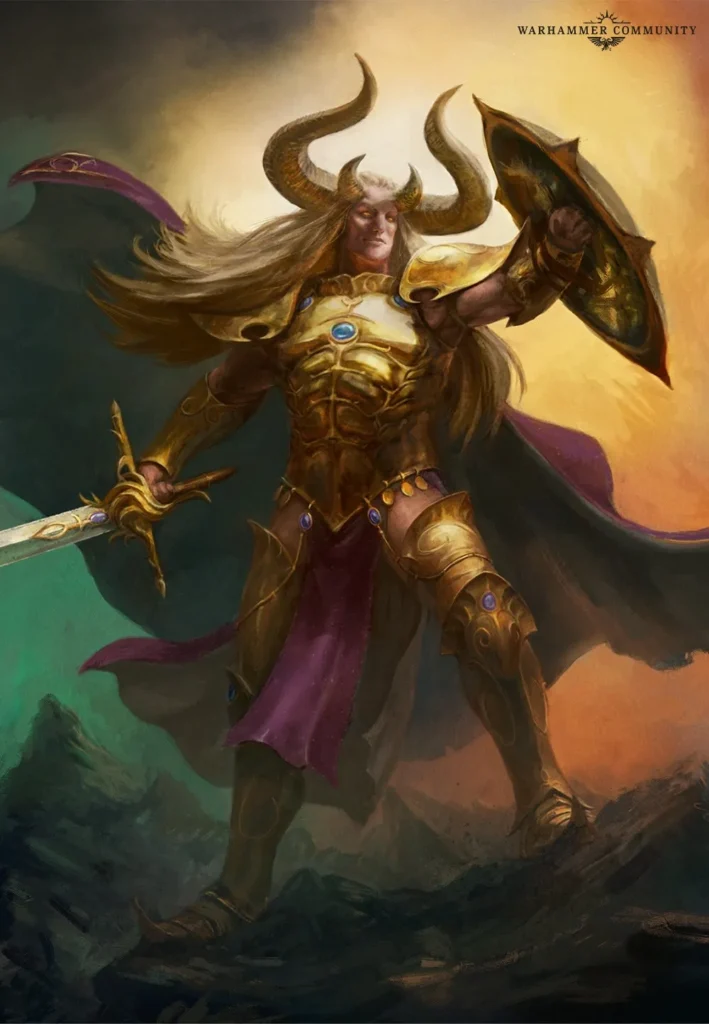
Sigvald is a Chaos Lord of Slaanesh, famed for his beauty and vanity. Born a Norscan prince, Sigvald turned to Slaanesh out of love for his own reflection.
In battle, he fights clad in shining armor, carrying a mirrored shield that allows him to gaze upon himself even amid combat. Yet beneath this polished exterior, Sigvald is a depraved soul, indulging in acts of cruelty and excess.
The Daemonic Legions of Slaanesh
Alongside mortal followers, Slaanesh commands daemonic legions within the Warp, beings crafted from the Dark Prince’s own essence. Daemonettes, fiends, and greater daemons such as the Keepers of Secrets serve as extensions of Slaanesh’s will, embodying its desires and wiles. Each daemon reflects a different facet of Slaanesh’s power, from the seductive allure of the daemonettes to the fearsome, predatory nature of the fiends.
1. Daemonettes
Daemonettes are Slaanesh’s most common servants and are striking in their androgynous beauty. They appear as graceful, lithe figures, with claws sharp enough to rend armor and flesh alike.
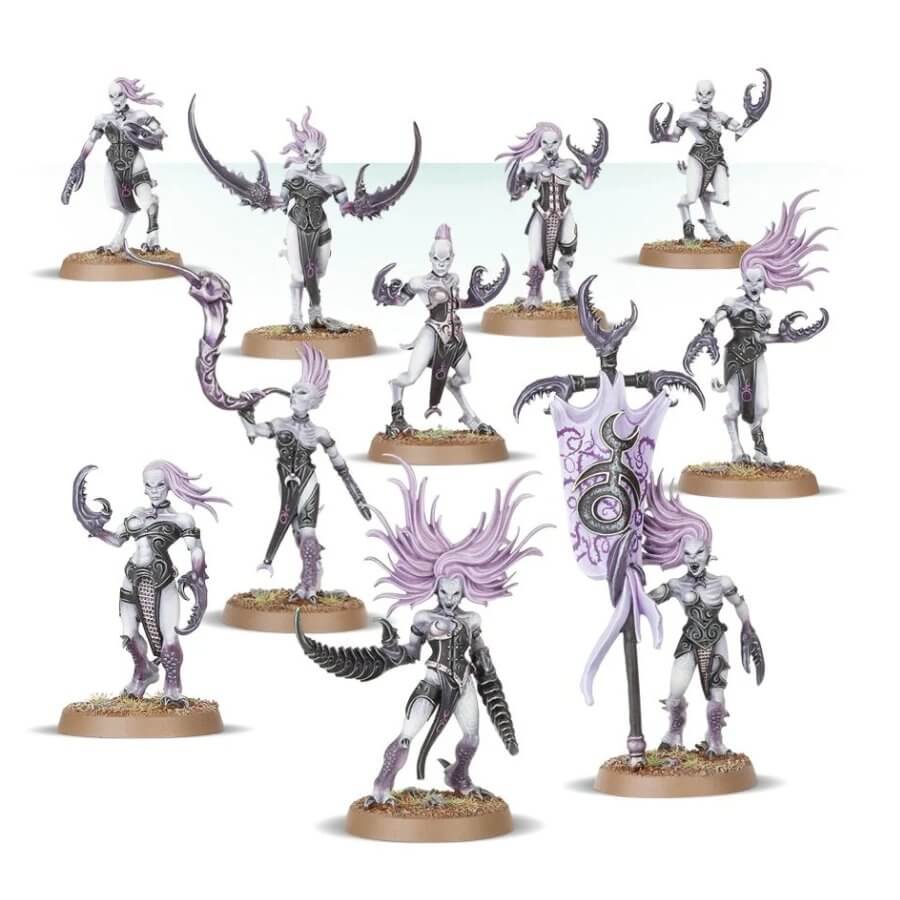
In battle, they move with unsettling elegance, dancing through the fray as if performing an artful display. They are drawn to those who are easily seduced by beauty or vanity and are particularly effective in battles where such traits are present among their foes.
2. Fiends of Slaanesh
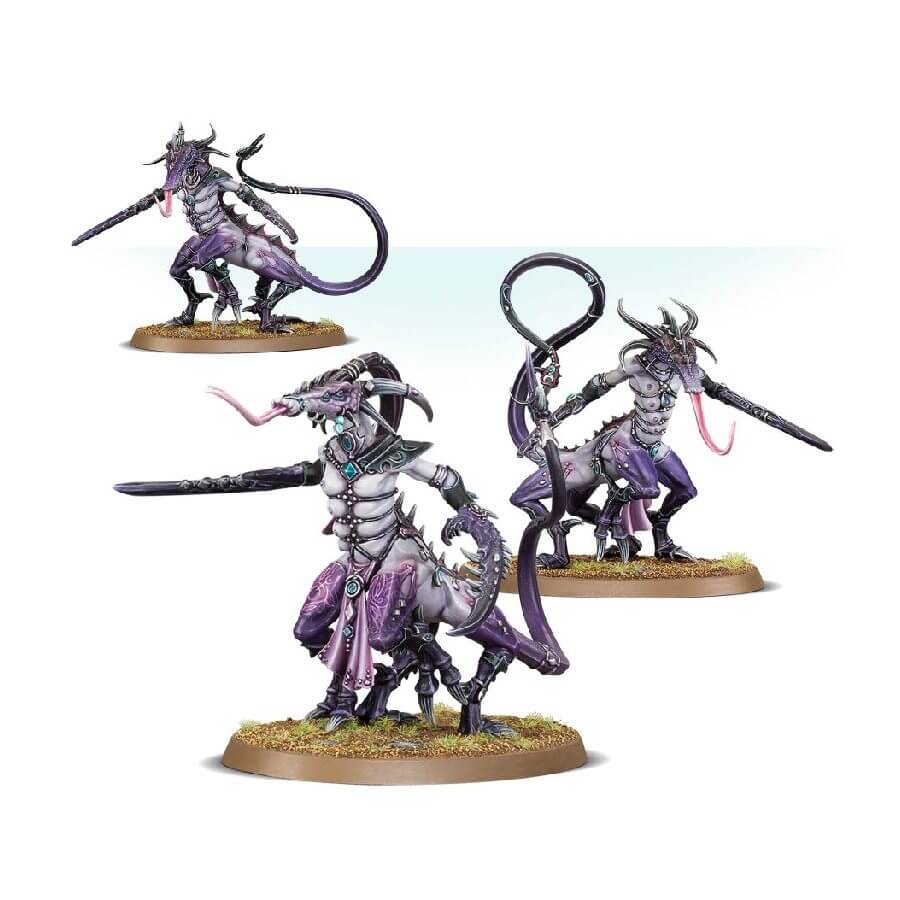
These bizarre creatures combine elements of allure and grotesqueness, blending sleek bodies with unsettling anatomical features.
Fiends exude pheromones that confuse and pacify enemies, making them easy prey. Their presence on the battlefield disorients even the bravest of warriors, creating openings for Slaanesh’s forces to exploit.
3. Keepers of Secrets
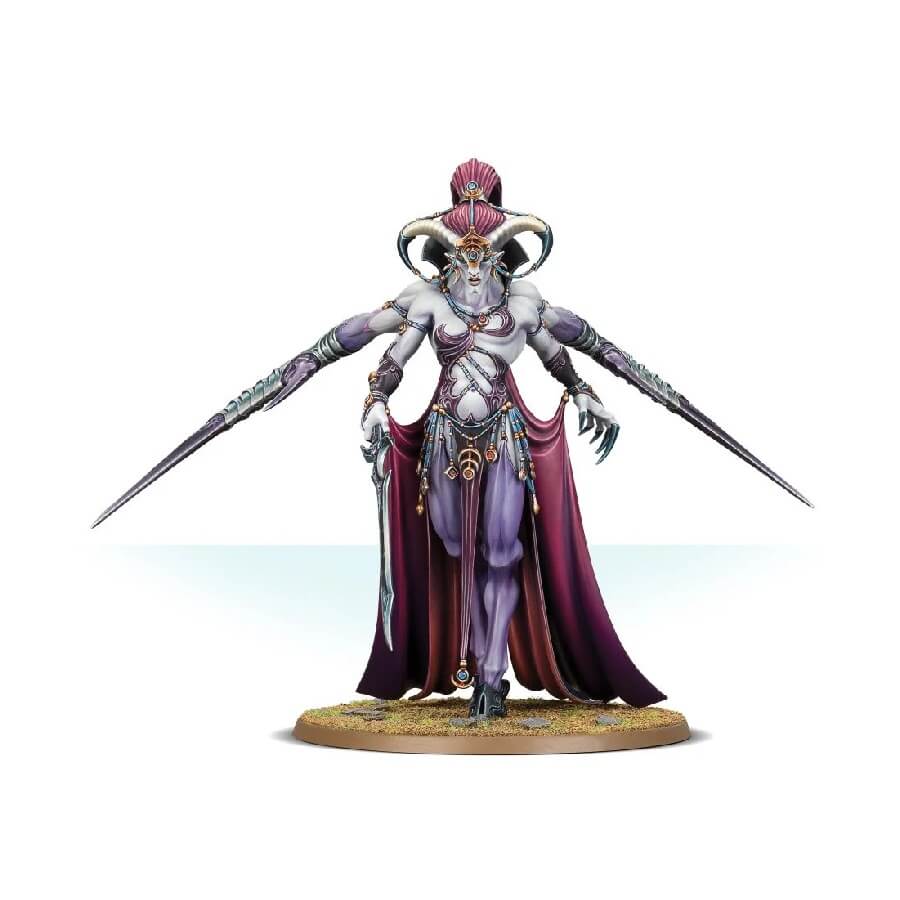
The Greater Daemons of Slaanesh, Keepers of Secrets are towering figures that embody the ultimate indulgence and depravity. These daemons possess powerful psychic abilities, often using their powers to manipulate emotions and sensory perceptions of their enemies, driving them to madness before delivering a fatal blow.
4. The Masque of Slaanesh
The Masque is a unique Daemonette who serves as Slaanesh’s chosen performer. Once favored by the Dark Prince, she fell out of favor and was cursed to dance eternally.
The Masque appears on battlefields to enrapture and disorient foes with her dance, leaving them vulnerable to attack. Her performances are mesmerizing, twisting the minds of those who gaze upon her in fascination and horror.
Each of these daemons represents an aspect of Slaanesh’s domain, from beauty and allure to violence and domination. When they march in the mortal realms, they create scenes of horror and fascination, drawing in both followers and victims alike. T
he sight of Slaanesh’s legions is as mesmerizing as it is terrifying, an invasion of sensations that leaves survivors forever marked.
The Taint of Slaanesh in the Imperium and Beyond
The Imperium of Man, for all its rigid control and dogmatic governance, is not immune to the allure of Slaanesh. The Imperium’s strict doctrines often create a fertile ground for corruption, as citizens and even high-ranking officials seek release from the oppressive weight of imperial rule.
Within the underbelly of hive cities and the decadent halls of noble houses, Slaanesh cults blossom, their rites hidden from the prying eyes of the Inquisition and the Adeptus Arbites.
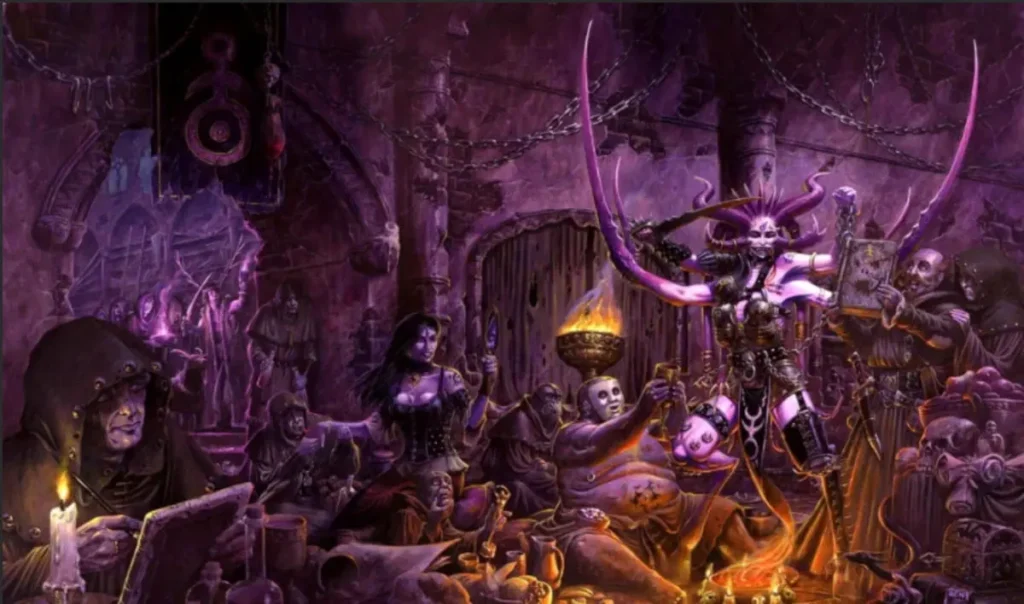
The Heresy of Indulgence: Slaanesh Cults in the Imperium
The Cults of Slaanesh operate like an insidious infection, spreading quietly within society, corrupting from within. Here’s a deeper look into how these cults lure followers, from the first enticing whispers to the eventual descent into depravity.
1. The Allure of the Forbidden and the Elite
Slaanesh’s cults are masters of subtle seduction, drawing in members under the guise of art, beauty, and liberation. Imagine a group of nobles, tired of their cloistered lives, forming a “Society for Aesthetic Excellence” in a hive city’s upper reaches.
Initially, they gather to discuss art, sensory experiences, and cultural philosophies. These societies may start innocently enough, exploring new perfumes or arranging exclusive recitals, but soon the gatherings escalate—seeking more extreme experiences, reaching into the taboo.
They move from rare wines to concoctions that alter the mind and senses, from poetry recitals to performances that strip away any semblance of restraint.
Take, for example, the infamous Amber Lotus Society on the hive world of Trieste VII. Initially formed by young aristocrats seeking to “enrich” their lives, the society quickly spiraled into a cult of Slaanesh. What began as high-society salons discussing abstract beauty became orgies of sensory indulgence, where participants sought new extremes to touch the divine.
The Society’s leadership soon entered pacts with daemons, in which they received supernatural beauty and enhanced sensations in exchange for unwavering service to Slaanesh.
By the time Imperial authorities intervened, the cult had infected the highest levels of Trieste VII’s nobility, and the hive’s fall to Slaanesh was inevitable.
2. Artists and the Pursuit of Perfection
Artists are also prime targets for Slaanesh’s cults, seduced by promises of perfection in their craft. Slaanesh’s followers might infiltrate an artist’s guild or collective, whispering that true artistry lies not in restriction, but in the pure, unfiltered expression of sensation and emotion.
At first, artists might simply push their art to new, unconventional limits, painting shocking images or sculpting in alien, provocative forms. But over time, they become obsessed, sacrificing anything—including sanity and humanity—to achieve ultimate beauty or the “perfect form” in their work.
On the pleasure planet Lysera, renowned sculptor Callisto Zen fell into the grip of a Slaanesh cult that promised him divine inspiration. His works, which were once praised for their intricate beauty, turned disturbing, depicting twisted, ecstatic forms that seemed to writhe under the viewer’s gaze.
As his obsession grew, he transformed his entire atelier into a temple to Slaanesh, culminating in a ritual that summoned daemonic entities to inhabit his creations.
By then, the art community of Lysera was complicit, its members lost to the same dark desire for transcendence.
3. The Rise of the “Hidden Seekers” – Secret Societies of the Upper Class
Slaanesh’s cults are especially dangerous among the powerful and influential, who spread corruption quickly. These societies often draw in prominent figures seeking to unlock the “secrets of the universe,” offering them forbidden knowledge in exchange for their loyalty.
Under the banner of “seeking enlightenment” or “refining the soul,” they indulge in practices that gradually strip away their humanity.
An example of this is the Hidden Seekers of Zalthar IV, a cult that counted several planetary governors among its ranks. They sought eternal youth and vigor, abandoning all sense of morality in exchange for it.
The cult orchestrated clandestine gatherings, experimenting with the forbidden sciences and pacts with entities beyond the Warp.
Over time, their “enlightenment” transformed into monstrous acts, and soon entire sectors of Zalthar IV’s upper crust were inducted.
When the cult’s influence was uncovered, the Inquisition ordered a full-scale purge, uncovering horrific rites that left their communities permanently tainted.
4. Recruitment Tactics: Promising “Liberation” from Society’s Chains
Slaanesh cults thrive on appealing to society’s misfits and discontented, offering them a way to “break free” from conventional limitations. Cult members often approach those who feel trapped, offering escape from mundane life through Slaanesh’s promises of unrestrained freedom and ecstasy.
What starts as curiosity becomes addiction, and once they’ve tasted the extremes of sensation, few can pull themselves away.
For example, in the spire city of Garamon’s Reach, an underground Slaanesh cult known as the Eternal Revel recruited among the disaffected youth. The cult lured recruits with promises of secret gatherings, where they could cast off societal expectations.
Over time, these recruits became zealots, wholly devoted to Slaanesh’s creed, driven to spread the cult’s influence. By the time the city’s rulers realized the extent of the corruption, entire districts had fallen to anarchy, with daemonic apparitions sighted in the streets.
5. Transformation of Innocent Societies into Horrific Rituals
The descent of Slaanesh cults from subtlety to open depravity is inevitable. Initially, cult members might only indulge in mild taboos, like drug use or illicit gatherings, believing they’re simply embracing life’s fullness.
But as Slaanesh’s influence grows, their need for ever-greater indulgence drives them toward horrifying rituals. What began as secret meetings becomes overtly daemonic worship, complete with blood sacrifices, rites of excess, and the appearance of daemonic entities.
The cult known as the Violet Embrace on the pleasure world of Kalithis began as a high-society group dedicated to “honoring beauty.” However, it devolved into a cult of ecstatic worship, with members embracing every form of excess, driven to extremes of beauty and indulgence.
Their leader, a once-renowned singer, was granted a daemonic boon, allowing her to enthrall others with her voice, but at the cost of her humanity.
The cult soon took over entire sectors, hosting orgies and blood sacrifices in the name of Slaanesh, until an Inquisitorial purge dismantled the organization at great cost.
6. Entrenchment and Societal Collapse: Too Late for Redemption
By the time society realizes the full extent of Slaanesh’s influence, it’s often beyond redemption. Entire communities become dens of depravity, their leaders corrupted and populace entranced.
At this stage, even drastic intervention may not be enough. The cult’s corruption has woven itself into the fabric of society, its influence impossible to fully extract.
The collapse of Caerus Prime is a stark example. There, Slaanesh cults had ingrained themselves so deeply within society that purges only fueled greater resistance. The cults grew bolder, and the populace willingly participated in daemonic rites, fully embracing Slaanesh’s promises.
Ultimately, the world descended into such chaos that the Imperium had no choice but to declare Exterminatus, destroying Caerus Prime in an attempt to prevent Slaanesh’s influence from spreading to other worlds.
The Corruption of Hive Worlds: An Ever-Present Threat
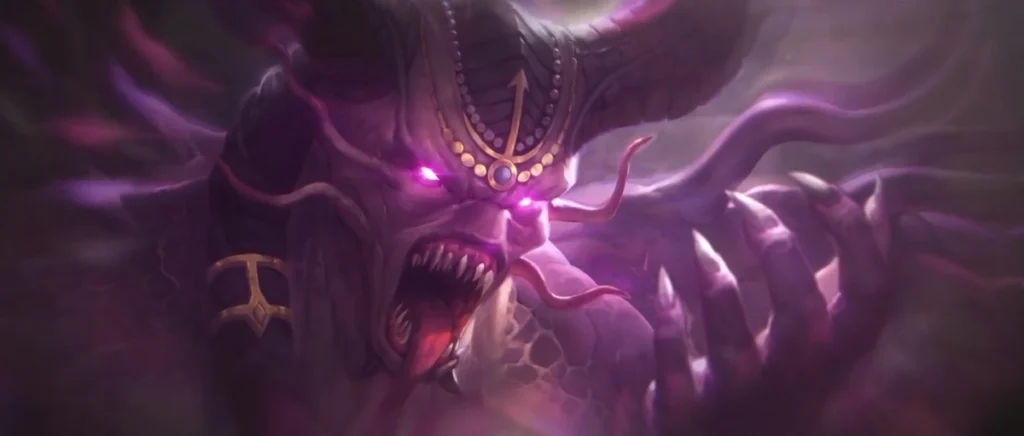
1. The Desperation of Industrial Workers
In the lower levels of hive cities, countless workers toil endlessly in factories, mines, and refineries, often for little reward and under brutal, life-threatening conditions.
This relentless existence drives many to seek pleasure or release wherever they can find it, often through illicit substances, dangerous gatherings, or thrill-seeking violence.
Slaanesh cults thrive here, presenting themselves as liberators, offering a life beyond the drudgery through “rites of indulgence” that promise ecstasy and an escape from the gray monotony.
One infamous example is the Hive City of Valken’s Reach, where the labor class fell almost entirely to Slaanesh worship. What began as secret gatherings of workers seeking relief from their backbreaking shifts quickly spiraled into orgies of excess, where physical pain and pleasure were one and the same.
Over time, these cults embedded themselves into the community, their influence reaching the city’s gang networks and spread through the workforce like a contagion.
In the end, Valken’s Reach succumbed to madness, and when Imperial forces arrived, they found the populace too far gone to redeem, ultimately ordering an Exterminatus to eradicate the corruption.
2. The Corruption of Gangs and Crime Syndicates
Gangs are rife within hive worlds, often ruling entire sectors and providing services or security to the population. When Slaanesh’s allure reaches these gangs, it manifests in violent rituals, sadistic displays, and a dangerous pursuit of physical and mental extremes.
Cults draw these gang members in with promises of supremacy, pleasure, and invulnerability, turning them into willing soldiers in Slaanesh’s growing army.
In the hive world of Promethar, a gang known as the Violet Talons fell under the influence of a charismatic Slaanesh cultist. The gang transformed into a ritualistic cult, where members sought “bliss” through extreme acts of violence and drug-induced trances.
They became predators, terrorizing the lower sectors, and as their influence spread, they began recruiting the children of the nobility who found the cult’s promise of liberation from their responsibilities alluring.
The cult’s influence reached the highest echelons before it was brought to an end by an Arbites raid, but not before countless lives were lost, and the hive city remained permanently scarred by the experience.
3. The Corruption of Planetary Enforcers and Officials
While most assume the poor or desperate fall to Slaanesh first, the rot often seeps into the ranks of planetary enforcers and officials as well.
Some officers, disillusioned by their brutal jobs or enticed by the promises of pleasure and influence, begin to sympathize with or even join Slaanesh cults. Their fall accelerates societal decay, as those meant to protect and uphold order instead sow corruption from within.
On the hive world of Malfidon Prime, for instance, a precinct captain known as Tevron Rayne was seduced by Slaanesh after being introduced to a secretive club promising “freedom from the shackles of duty.” The club, in reality, was a front for a Slaanesh cult that held clandestine ceremonies where members would partake in sadistic rituals.
Rayne, at first appalled, quickly found himself drawn in by the sheer power of abandoning restraint. Under his watch, corruption spread through the ranks of enforcers, enabling the cult to operate with impunity, silencing any dissent and punishing those who tried to leave.
By the time the Inquisition intervened, the hive world was in open chaos, with entire precincts turning on one another in horrific displays of excess and violence.
4. Societal Collapse and the Inevitable Descent into Madness
When Slaanesh’s influence spreads unchecked on a hive world, it doesn’t just corrupt individuals—it erodes the foundations of society itself. Entire communities can become dens of decadence and depravity, where cultist doctrines replace any semblance of law or order. In these environments, the thin veil between reality and the Warp grows weak, inviting daemonic incursions and even larger-scale manifestations of Slaanesh’s will.
One tragic case is the hive world of Destra IV, where Slaanesh cults infiltrated the populace to the extent that normal life became impossible. Violent riots broke out as cults clashed for dominance, their leaders driven mad by visions of Slaanesh’s promises.
Desperate to maintain some form of order, planetary officials shut down entire sectors, but the cults only grew stronger, using abandoned districts as bases of operation.
Soon, warp anomalies began manifesting, drawing in lesser daemons, until the entire hive city became a roiling battleground of hedonistic chaos.
When the Inquisition arrived, Destra IV’s entire population was declared irredeemable, and an Exterminatus was executed, obliterating all life to prevent Slaanesh’s corruption from spilling further.
The Tragic Consequences of Exterminatus: A Necessary Evil
When Slaanesh’s corruption becomes too deeply embedded, the Imperium has no choice but to enact Exterminatus, eradicating all life to purge the hive world of its taint. This measure, while drastic, is seen as necessary to prevent the contagion from spreading to nearby systems.
However, the aftermath of such an act leaves scars not only on the Imperium but on those who are tasked with its execution.
Entire worlds—each one a hive of millions or even billions of lives—are lost to the depravity that Slaanesh brings, underscoring the terrifying reach and cost of the Dark Prince’s influence.
The Twisted Legacy of Fulgrim and the Emperor’s Children
No discussion of Slaanesh’s presence in the galaxy is complete without mentioning Fulgrim, the Primarch of the Emperor’s Children, and his tragic descent.
Once a warrior dedicated to the pursuit of perfection, Fulgrim’s ambitions led him down a dark path when he encountered a cursed sword containing a daemonic entity. This encounter marked the beginning of his fall, as he became ensnared by Slaanesh’s promise of ultimate perfection.
Fulgrim’s transformation was swift and catastrophic, with his drive for excellence morphing into an insatiable need for excess.
He led the Emperor’s Children in acts of unspeakable depravity, their once-noble pursuit of martial and artistic excellence degraded into hedonistic revelries.
Fulgrim’s embrace of Slaanesh marked him as one of the most tragic figures among the Primarchs, a symbol of how even the noblest intentions can be twisted by Chaos.
Under Fulgrim’s leadership, the Emperor’s Children became the epitome of Slaanesh’s ideals, their battles turning into orgies of violence and ecstasy. They transformed their once-perfect bodies with implants, mutations, and adornments, becoming grotesque parodies of beauty and refinement.
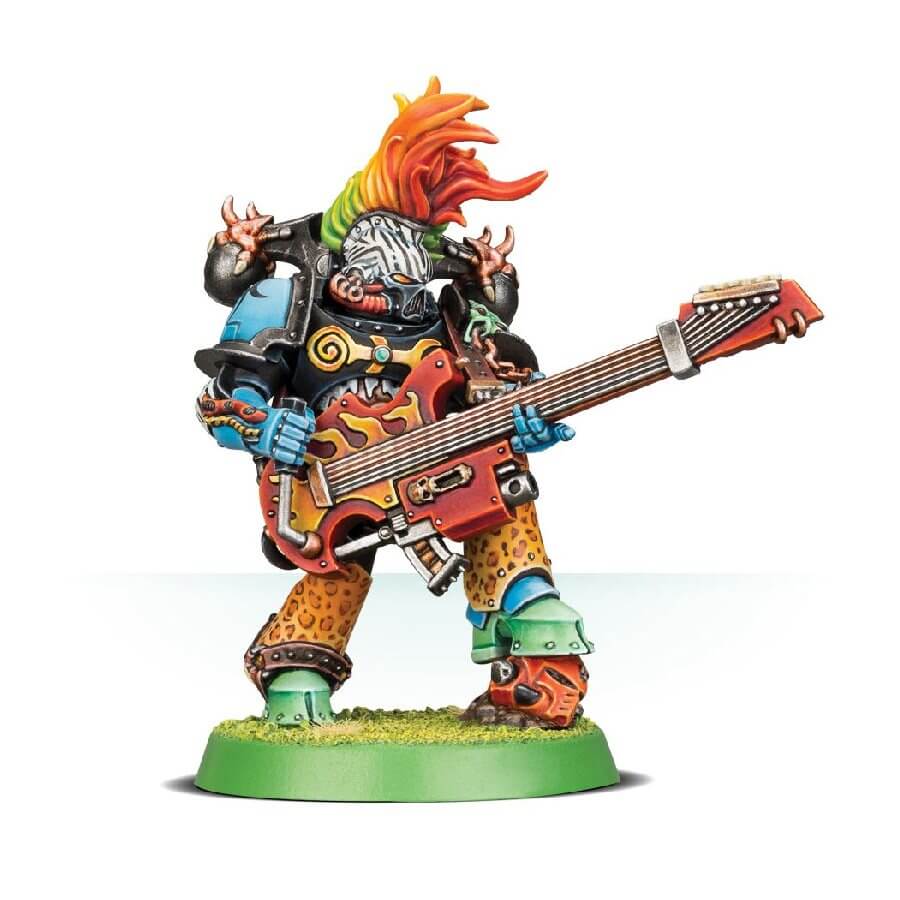
These warriors, now the Noise Marines, wield sonic weaponry that delivers both pain and pleasure to those caught in their range. Their presence on the battlefield brings a symphony of screams and destruction, encapsulating Slaanesh’s love of blending beauty with horror.
The Drukhari: Allies or Rivals?
Slaanesh’s connection to the Drukhari, the dark cousins of the Aeldari, is a complex one. While Slaanesh was born from the downfall of their ancient empire, the Drukhari are not direct worshippers of the Dark Prince.
Instead, they view Slaanesh as a relentless enemy, a devouring force that eternally hungers for their souls. The Drukhari’s cruel society and practices were largely developed as a means of avoiding Slaanesh’s grasp, as they sustain themselves on the suffering of others to evade the Prince’s attention.
However, the relationship between Slaanesh and the Drukhari is not solely adversarial. Some Drukhari are drawn to the forbidden allure of the Dark Prince, and Slaanesh’s influence can occasionally be seen in their hedonistic, sensation-seeking culture.
There are whispers within Commorragh of cults dedicated to Slaanesh operating in the shadows, even as the Kabals seek to keep their souls away from the Dark Prince’s reach.
The delicate balance of fear and fascination defines the Drukhari’s stance on Slaanesh, illustrating the god’s paradoxical nature in the Aeldari psyche.
Slaanesh and the Aeldari Paths: The Struggle for Souls
The Aeldari’s struggle with Slaanesh goes far beyond simple avoidance—it is a relentless fight against the very nature of their psyche and culture.
Each example of an Aeldari slipping from the strict disciplines of the Path is a potential gateway for Slaanesh, whose allure exploits even the smallest cracks in their mental and emotional fortitude.
Let’s explore several poignant examples of how the Dark Prince tempts and ensnares the Aeldari.
1. The Story of Prince Yriel: The Danger of Pride and Recognition
Prince Yriel, a powerful Aeldari Corsair, once walked a path of defiance and pride that nearly brought him to the brink of Slaanesh’s clutches.
Known for his martial skill and fierce pride, Yriel refused to follow the Paths of the Craftworld, instead choosing the life of a rogue Corsair—a life fraught with temptation and excess.
His pride drove him to extraordinary feats, but it also made him vulnerable. Though Yriel ultimately returned to his Craftworld, he brought with him the Spear of Twilight, a cursed weapon of immense power that slowly siphons his life force with each use.
The Spear’s dark allure and the agony it inflicts resonate with Slaanesh’s desire for exquisite sensations, blending triumph with suffering.
Yriel’s story is one of heroic sacrifice but also serves as a cautionary tale about the thin line the Aeldari walk. While he did not directly succumb to Slaanesh, the ever-present threat looms as he continues to wield the cursed weapon, risking his soul in his fight for the Aeldari’s survival.
2. The Path of the Seer: The Risk of Psychic Power
For Aeldari psykers, particularly those who follow the Path of the Seer, Slaanesh’s temptations manifest through their intense psychic abilities.
The use of psychic power among the Aeldari is akin to walking a razor’s edge, for every act of will or feat of foresight can pull them toward Slaanesh’s gaze. The Craftworld Seers must navigate the inherent pleasure that psychic power brings, controlling and repressing their desire to wield it beyond necessity.
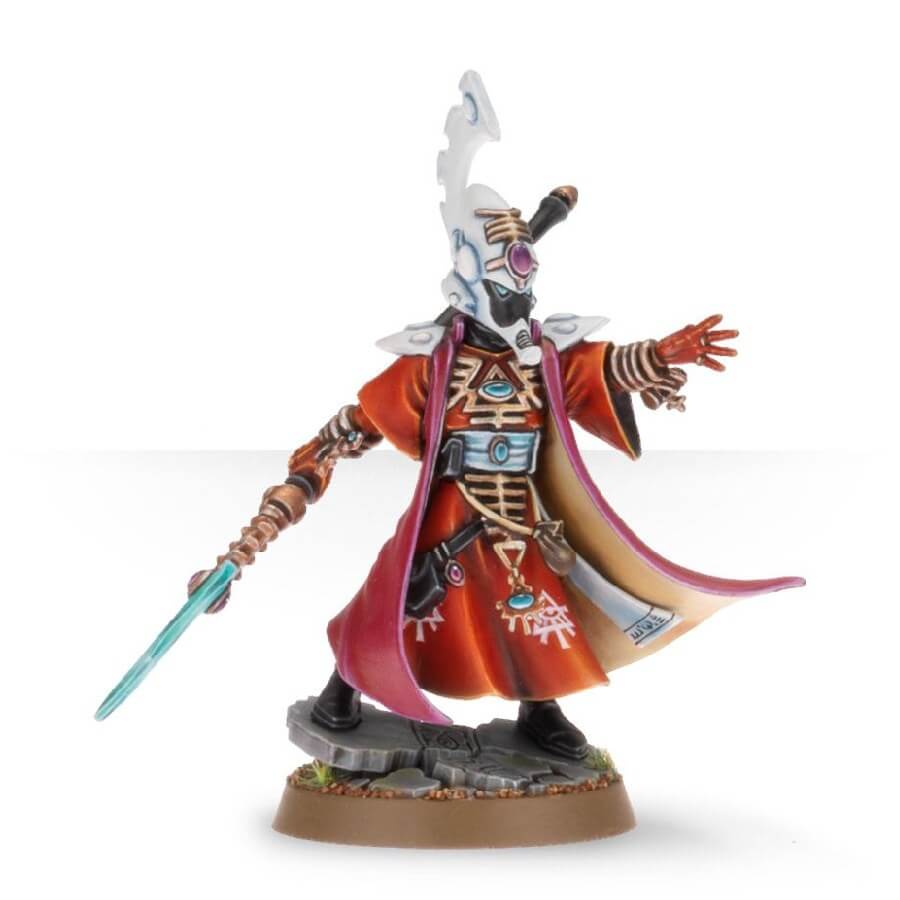
Take the tragic case of Farseer Auric, who, during a vision, glimpsed a universe of unimaginable beauty and sensory delight. Driven by curiosity, he began to delve deeper into the nature of these visions, finding himself increasingly drawn to their allure.
Eventually, Auric became consumed by his desire to experience these sensations in reality, abandoning the Path of the Seer and eventually falling to Slaanesh. His soul was claimed in his final vision—a potent reminder of how even the disciplined minds of the Seers can be swayed by Slaanesh’s seductive promises.
3. The Path of the Artisan: The Search for Perfection
Aeldari artisans, tasked with preserving and creating beautiful works that reflect the lost grandeur of their civilization, are particularly vulnerable to Slaanesh’s temptations.
These artists, striving for perfection, may find themselves yearning for the impossible heights their people once reached. Slaanesh’s influence creeps in, offering whispers of techniques and inspirations that would bring them closer to that lost ideal of perfection.
One famed artisan, Kaelis Vora, was known for her astonishingly beautiful sculptures that seemed to capture the essence of her people’s ancient glory. Her obsession with recreating the beauty of the Aeldari’s past became all-consuming, and she began to experiment with forbidden methods to attain greater realism and intensity in her work.
One day, her apprentices discovered her final piece: a sculpture of otherworldly beauty, but on closer inspection, it was made from materials and methods that had clearly been influenced by the Dark Prince. Kaelis had disappeared, her soul likely claimed by Slaanesh.
Her tragic story serves as a reminder of the inherent risk in the Aeldari’s pursuit of perfection, where beauty and ruin walk side by side.
4. The Path of the Warrior: The Lure of Exquisite Combat
The Aeldari Path of the Warrior channels the rage and thrill of combat into disciplined forms, allowing Aeldari to embrace war without falling to their emotions.
However, in the heat of battle, some warriors find themselves captivated by the beauty of combat, each motion an art form, each kill a testament to skill and precision. This mindset can be perilous, as it closely aligns with Slaanesh’s values.
One infamous example is that of Asurmen’s disciple, Ilaethe, who sought to push herself beyond the confines of her training. She strove to make each strike perfect, each movement graceful, until battle became less about survival and more about the artistry of it.
While she remained a disciplined warrior on the surface, her fixation on the beauty of her movements led her down a path where Slaanesh’s influence began to seep into her psyche.
Only the intervention of her fellow warriors saved her, forcibly removing her from the Path and isolating her to prevent further descent.
Ilaethe’s story illustrates how even the most disciplined warriors can be drawn into Slaanesh’s web through their pursuit of mastery.
The Eternal Appeal of Slaanesh: A God Who Offers Freedom, At a Cost
In a galaxy ruled by the rigid doctrines of the Imperium, Slaanesh presents itself as a form of rebellion and liberation. For many, the strictures of the Imperium and the constant threat of violence make life a prison, one in which individuality, creativity, and joy are suppressed in favor of duty.
Slaanesh appeals to those who long to break free, who crave something beyond the gray existence that the Imperium enforces.
In this way, Slaanesh offers not just temptation, but a kind of freedom—a place where desires can be explored without judgment or restraint.
However, this freedom is an illusion. The “gifts” of Slaanesh inevitably bind its followers to a cycle of endless craving.
What begins as liberation from societal norms becomes an unbreakable chain of dependency on Slaanesh’s whims. The Dark Prince offers everything, but in the end, its followers are left with nothing but an insatiable emptiness.
FAQs
Why does Slaanesh have both male and female forms?
Slaanesh embodies desire and excess, which transcend gender. The god appears as whatever is most alluring to each individual, making Slaanesh an androgynous entity that shifts form as needed to attract and seduce.
How does one become a follower of Slaanesh?
Followers are typically drawn to Slaanesh through their own desires and ambitions. Artists, warriors, and hedonists, in their pursuit of greatness or pleasure, often find themselves in the Dark Prince’s grip without even realizing it. Once they accept Slaanesh’s influence, their path becomes one of endless indulgence and excess.
What is the ultimate fate of Slaanesh’s followers?
Followers of Slaanesh are eventually consumed by their desires, becoming addicted to experiences that can never truly satisfy them. Upon death, their souls belong to Slaanesh, trapped in his domain where they will endure both pleasure and suffering for eternity.
Why does Slaanesh target the Aeldari so fervently?
The birth of Slaanesh led to the near-extinction of the Aeldari, and their souls are particularly sweet to the god due to the high psychic potency of their race. Slaanesh’s eternal hunger for Aeldari souls is part of a personal vendetta, a hunger for the race that inadvertently brought the god into existence.
What does Slaanesh look like?
Slaanesh appears as an androgynous figure of impossible beauty, blending masculine and feminine traits with an almost hypnotic allure. Their form embodies perfection and excess, with iridescent hair, entrancing eyes, and an aura that morphs to reflect the deepest desires of anyone who beholds them. This mesmerizing appearance captivates followers, drawing them into worship and indulgence that ultimately leads to ruin.
What is the Mark of Slaanesh?
The Mark of Slaanesh is a symbol bestowed on the most devoted followers, granting them supernatural charisma, seductive power, or heightened senses. Bearers often use these gifts to further spread Slaanesh’s influence, though the mark also leads them further into depravity.

